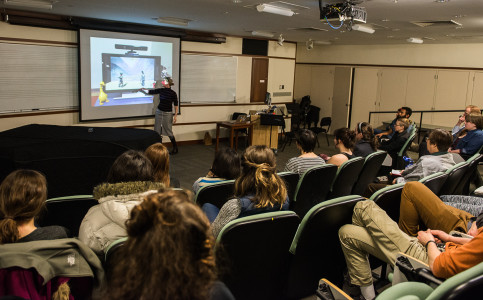Emma Friedlander, Arts Editor
friedlan@grinnell.edu
The liberal arts often seek the connection between the arts and sciences. The Cultural Technology Development Lab (CTDL) may have found one such overlap.
This week, Miriam Langer, Professor of Media Art and Technology at New Mexico Highlands University, visited Grinnell with two members of the CTDL team, Miles Tokunow and Rianne Trujillo. The team stayed at Grinnell throughout the week in order to show students how they could incorporate the CTDL’s open-source technology into their own exhibits. On Monday, Feb. 8, Langer delivered a talk in Bucksbaum Center for the Arts on the CTDL’s mission and accomplishments.
“We develop technological solutions for museums, libraries and cultural institutions,” Langer said. “This project started to help museums get technology they could use themselves, and also feel empowered to request, fix and change. We want cultural organizations to ask for the experience that they know best, and which will best accommodate their visitors.”
To illustrate this concept, Langer, Tokunow and Trujillo presented a variety of the technology they have installed into cultural organizations throughout New Mexico and beyond. These included interactive pneumatic tubes at the Santa Fe Children’s Museum and digitized dancing marionettes at the Baumann Marionette Project. Langer remarked that the latter is especially important because it innovates antiques that are unique to New Mexican folk tradition and are otherwise locked away in vaults and inaccessible to the public.

Langer also demonstrated an interactive birdcall exhibit that the CTDL developed for Arcadia National Park Nature Center in Maine. In the exhibit, visitors touch models of a bird’s egg to models of the appropriate bird which then produces that bird’s call if matched correctly. Langer stressed that this simple innovation could help interaction and accessibility not only at Arcadia National Park but also in myriad cultural institutions.
“Each of these sets is really inexpensive,” Langer said. “Our technology is all open-source and we can share the files. Anyone who wants to build something like this can follow our examples and build it, whether it’s birds or anything else you might want to match.”
The CTDL has also developed Museduino, an open-source hardware kit that can be used in installations and exhibits by museums.
“This was our way of contributing to museums and institutions that want to start doing hands-on electronics in-house without a huge amount of investment,” Langer said. “We created Museduino and brought it to the Association of Science and Technology Center and demonstrated the technology to science, technology and children’s museums from all around the world.”
Although the specialty of the CTDL is museum technology, Langer stressed that this technology serves solely to enhance the cultural experience, not to detract from it.
“It’s no accident that the word culture comes before the word technology,” Langer said. “We really believe the technology is there to serve the culture and that it’s not about the reverse. We’re there to make collections more accessible.”
The event was attended by many students in the Art Department who were interested in seeing how they could implement simple and user-friendly technology into their own work.
“I’m an art major and also interested in technology,” said Doyi Lee ’16. “It’s interesting to see how the two work together and that there are programs out there that can help me develop. It shows me what I can do in the real world to make that happen. I didn’t even know people were doing this! That’s the greatest takeaway.”




























































